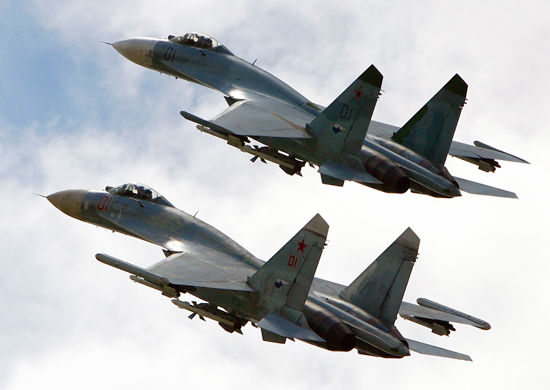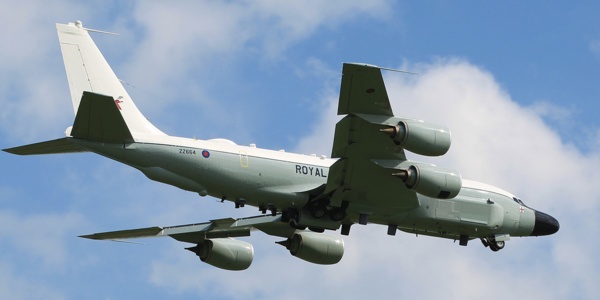Miscommunication results in the Russian Su-27 firing on the British RC-135. Fortunately, the missile ran into problems
4 min read
A misunderstanding nearly caused a Russian fighter to shoot down a British spy plane, US officials said in recently leaked intelligence documents. The authorities said it was more serious than they initially stated.
A Russian fighter fired a missile at a British reconnaissance plane flying over the Black Sea in September last year, but the missile malfunctioned, according to US defense officials. The incident was more serious than originally depicted and may have been considered an act of war.
According to US defense officials, the Russian pilot misinterpreted what a radar operator on the ground told him and thought he had permission to fire. The pilot, who had closed in on the British aircraft, opened fire, but the missile failed to launch properly.
In October, British Defense Secretary Ben Wallace described the situation as “potentially dangerous” in briefing members of parliament after a “Russian fighter fired a missile in very close proximity” to the British aircraft. But one of the leaked documents said the Sept. 29 incident was “close to bullets.”
The Russian embassy in Washington did not respond to a request for comment.
The dance between U.S. and other NATO surveillance planes and Russian fighter jets over the Black Sea has been going on for years, especially after Russia illegally annexed Crimea in 2014. Tensions have only escalated as Ukraine increasingly relies on more intelligence. collected by the West. To resist the Russian invasion that began last year.
Last month, a Russian warplane collided with a US reconnaissance drone over the Black Sea, hitting the drone’s propeller and causing it to crash in international waters. The collision was the first known physical contact between the Russian and American military since the beginning of the war in Ukraine.

The two American defense officials with first-hand knowledge of the impending gunfire in September confirmed the seriousness of the encounter between the British jet — a four-engine aircraft known as the RC-135 Rivet Joint — and two Russian Su-27 fighter jets. The British aircraft has a crew of about 30 and is capable of intercepting radio traffic.
Defense officials said they spoke on condition of anonymity to discuss sensitive issues Rivet Joint had been listening in on intercepted communications between a Russian radar controller on the ground and one of the pilots of the Russian Su-27s sent to monitor the plane.
The Rivet Joint ship was in international airspace off the coast of Russian-occupied Crimea. Officials said the Russian plane’s pilots were out of range of the British patrol but were equipped with missiles capable of hitting it.
One officer who was briefed on the encounter described it as “very frightening”.
Asked to comment on the New York Times report and the leaked document, a UK Ministry of Defense official said in a statement: “A significant proportion of the content of these reports is false, manipulated, or both. We strongly caution against anyone taking these claims at face value and also advise them to cast doubt on them.” The source and purpose of these leaks.”
In his October briefing to lawmakers, Wallace said he had conveyed his concerns after the incident to the Russian military, including Defense Minister Sergei K. Shoigu. The Kremlin indicated a “technical failure,” Wallace said, adding that it did not consider the incident a deliberate escalation by the Russians, according to a Reuters report at the time.
Mr. Wallace said that after the accident, Observation flights were initially suspended, but later resumed with fighter jet escorts. Now, the British Rivet Group patrolling the Black Sea flies at least one Typhoon fighter alongside.
The September incident has chilling echoes of a time during the Cold War, when Soviet fighter planes struggled to intercept what they feared was an enemy plane that was actually Korean Air Flight 007, a Boeing 747 passenger plane. A Soviet reporter, partially describing the passenger plane to a ground-based radar station, was given permission to fire.
All 269 people on board were killed after two air-to-air missiles hit the plane.
With rising tensions and misunderstandings a staple of wartime environments, NATO observation flights are now flying farther from Crimea than is required by international law. Instead of only 12 miles from the coast, which is considered international airspace, the US military currently polices a much wider range of about 46 miles.which was described in one of the leaked documents as a “SEDECDE target deadlock”.
The classified documents also indicate a series of air-to-air incidents involving Russian aircraft and NATO planes and drones that have occurred since the near miss on September 29. From October 1 to February 22, British, French and American flights responded to six different events in which Russian aircraft got close to their patrols, from distances of six nautical miles to just 100 feet.
source: New York times

“Devoted food specialist. General alcohol fanatic. Amateur explorer. Infuriatingly humble social media scholar. Analyst.”




